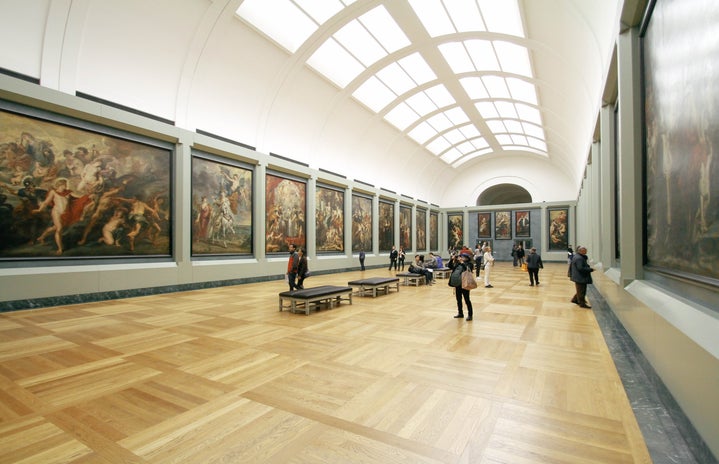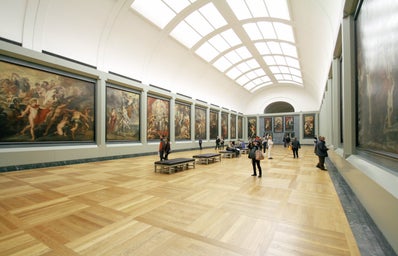Kimono is very popular right now and one can find cardigan-like clothes that claim to be kimono in many shops. It is famous for being comfortable and cut in a relaxing shape like bath robes. Kimono is even mentioned by Nellie Bly, a female journalist who travelled around the world in 72 days in 1889: “The best proof of the comfort of kimonos lies in the fact that the European residents have adopted them entirely for indoor wear. Only their long subjection to fashion prevents their wearing them in public.” (Nellie Bly, Around The World In Seventy-Two Days)
Although the simple kimono style worn by the general public became popular, it was completely different for noble women in the medieval age in Japan.
Traditional clothes for women
Tosa Mitsuoki, The portrait of Murasaki Shikibu via Wikimedia Commons
Kimono worn by high-ranking women at formal occasions in the Heian period (794-1185 AD) was so called jyunihitoe, formally called itsutuginu karaginu mo. It had about twenty kilograms and was consisted of many layers in this order:
Kosode… an underwear
Naga bakama… long pleated skirts
Hitoe…an unlined robe
Itsutuginu…lined robes, usually wearing five robes, their lengths are shorter than hitoe, but bigger than uwagi to show the beauty of their colors around a neck
Uchiginu…a robe
Uwagi…a robe, usually patterned woven
Karaginu…a short jacket, front side is longer than back side
Mo…an unlined long skirt down the back of the robe
Colours in jyunihitoe
There were many patterns of colors, and women were serious about the coordination of colours in three parts of jyunihitoe; the outer side and lining of robes, hitoe and itsutsuginu, the warp and the weft, to weave beautiful fabrics.
usuyou irome via National Diet Library
Firstly, two colors for the robes’ outer side and lining was called awase irome and the lining color could be seen through, because silk robes were very thin. There were some decided combinations of colors for each season and others for all seasons. Each combination was named after nature, such as flowers, trees, and insects.
usuyou irome via National Diet Library
Secondly, six colors for six each robe, hitoe and itsutuginu, was called kasane irome. There were basically four patterns of combination.
Nioi…similar color gradation
Usuyou…gradation becoming much paler color, then white
Murago…gradation with several different light and deep colors like a rainbow
Hitoe gasane…gradation of thin see-through unlined robes, worn in summer
Some combinations were also named after flowers and trees.
Thirdly, colors of the warp and the weft were decided to enjoy changing colors of fabrics.
This combination of colors was an important knowledge for people in medieval Japan and it was used to choose coloured paper for love letters as well. Women competed to display the beauty of the colors they chose to attract men’s attention, as it was written in some novels and poems.
Tosa Mitsuoki, The tale of Genji, Genji and Murasaki no Ue are inside, others playing with snow via Wikimedia Commons
In Genji Monogatari, The Tale of Genji, the first novel in the world written by the court lady Murasaki Shikibu, there are many scenes where people choose the colors of clothes and papers. The Tale of Genji is about playboy Genji who is the emperor’s son, and the many women he loved. It is interesting to read and compare these women’s robes. (If you are interested in, see here) For example, Genji chose robes for his lovers. The robes for Murasaki no Ue, his second wife, were ebizome color with Japanese red plum blossom crests and the imayou color. Ebizome was the color of fruits of ebikazura (vitis ficifolia) similar to grapes, dyed with murasaki sou (purple gromwell), and imayou is lighter color of kurenai which is pinkish and dyed with safflowers. You can see the vibrancy of their robes’ hem from this illustration.
Also, in Eiga Monogatari, Story of Splendor, a historical tale written by female unknown writers around the eleventh century, it is mentioned that a woman wore twenty robes to be more gorgeous, but she could not move because they were too heavy.
These many different Japanese colors are unique, precious, and made of natural materials such as flowers and trees. Hand-dyed silk threads in these colors are kept in the Victoria and Albert Museum in the UK.
Moreover, these colors will be used for 2020 Tokyo Olympic games. The Tokyo Organizing Committee of the Olympic and Paralympic Games announced that they chose five kasane irome, six colors combination, for official goods and decorating cities. It is Ai, Kurenai, Sakura, Fuji, and Matsuba. Ai is a Japanese indigo color, the so-called Japan blue and other blue colors; Kurenai is deep red dyed with safflowers and other red colors; Sakura is the cherry blossom color and other pinkish colors; Fuji is Japanese wisteria color and other purple colors, Matsuba is pine needles color and other green colors.
Empress Michiko wearing itsutsuginu karaginu mo at the Ceremony of the Enthronement, The Ministry of Foreign Affairs of Japan via Wikimedia Commons
Itsutsuginu karaginu mo is still worn by The Empress and The Crown Princess at formal attires such as wedding ceremony and Ceremony of the Enthronement.
Traditional clothes for men
Traditional clothes for men are much simple, but the color is also important. Noble men wore sokutai at formal occasion.
Emperor Komei’s kone (Chinese style clothes) via Wikimedia Commons
Before Japan made its own ceremonial style and clothes around tenth century, the Chinese style was used, and The Emperor and The Empress wore Chinese style clothes at the ceremony of Enthronement.
Emperor Akihito wearing Koirozen no gobo at the Ceremony of the Enthronement, The Ministry of Foreign Affairs of Japan via Wikimedia Commons
In the Heian period, Kourozen no gobo color is used for clothes that only the Emperor can wear. It is a yellowish brown color and dyed with skin of Japanese wax tree and sappan wood. It is said that this color was chosen for the emperor on 820. The crests on the robe changed many times depending on the Emperor. Some researchers considered Japan was influenced by Tang dynasty in China and chose yellow which was used for Chinese Emperor’s clothes as a symbol of the shining sun. Even after this color is decided, Chinese style clothes had been used until their abolition when Emperor Meiji succeeded to the throne in 1868.
The wedding ceremony of Emperor Akihito wearing Ouni no hou and Empress Michiko wearing itsutsuginu karaginu mo, Imperial Household Agency, via Wikimedia Commons
Ouni no hou is the color for only The Crown Prince which is reddish orange like a rising sun, dyed with safflower and cape jasmine. It was decided as the color for the Crown Prince in Nara period (710-794), which is earlier than The Emperor’s. There is a male mandarin duck crest on the robe.
The Emperor in ceremonial attire on the day of the Ceremony of Enthronement, The Ministry of Foreign Affairs of Japan via Wikimedia Commons
For the Ceremony of the Enthronement, the Emperor and the Empress wear these traditional robes, but they change into white ceremonial robes which have a same style later on the same day.
When and where we can see them?
You can see these traditional clothes which were worn by Emperor Akihito and Empress Michiko at the special exhibition at Nihonbashi Takashimaya Department Store. On the day of abdication, 30 April 2019, Emperor Akihito is going to wear Kourozen no gobo, Crown Prince Naruhito will wear Ouni no hou, and Empress Michiko and the Crown Princess Masako will wear itsutuginu karaginu mo. Also, at the Ceremonies of Enthronement, Crown Prince Naruhito will wear Kourozen no gobo, Crown Princess Masako will wear itsutuginu karaginu mo, and the white one as well, because they become the new Emperor and Empress. Though the color that male royals wear is decided, it is not so for women.
If you have a chance to see the ceremony on TV, it will be very interesting to view the color they used and which combination of colors they chose.


